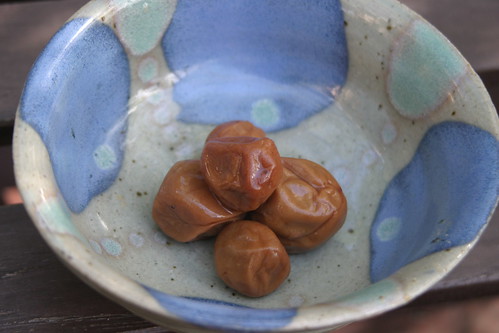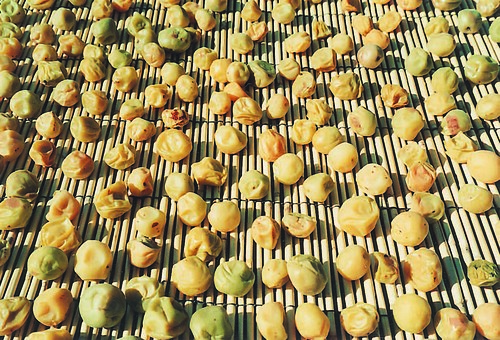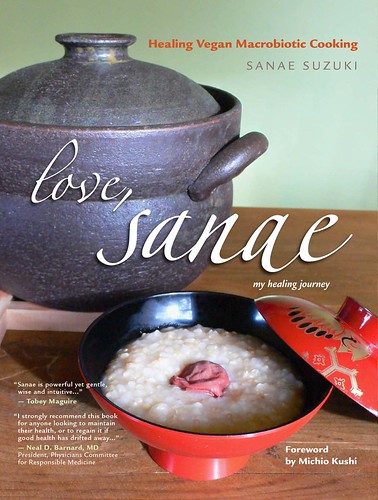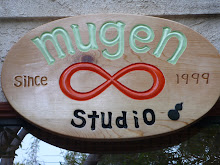special organic umeboshi plums from Oroville, California.
Umeboshi plums are traditional Japanese pickles used in morning porridge, sushi, rice balls, salad dressings, beverages and more. Pickled with red shiso (beefsteak) leaves and sea salt, these plums taste tart and sour.
Umeboshi plums are a super alkaline food for maintaining balance and aiding the digestive process.
kazuko's organic umeboshi plums in our original blue bowl:

Our long-time friend, Kazuko Yamazaki, moved to Orland, California in1968 from Japan with her husband, Jyunsei. They planted about 450 ume plum trees to realize their dream of making umeboshi plums in the U. S. They also grew red shiso leaves (Japanese medicinal herb beefsteak) in their property for making umeboshi plums. (Umeboshi plums’ reddish color comes from red shiso leaves.)
They made their umeboshi plums in the truly traditional way, as they grew the ume trees organically, picked the plums by hand, and sun dried them for three days under California’s long hours of sunshine. While sun drying they have to be turned frequently. I remember when I went to help them I learned to continuously turn each ume plum for hours so they wouldn’t get burned and stick to the bamboo matt.
They have only used selected choice sea salt and their home-grown red shiso leaves to make their premium hand-made umeboshi plums for many years.
Jyunsei passed in 2000 and Kazuko kept up the work by herself, but she eventually retired in 2008. Since Jyusei passed, she was not able to promote her umoboshi plums widely. Settled in a retirement home, Kazuko still has umeboshi plums for sale, so we decided not only to help her, but to seize this opportunity to spread the love and care with which she and Jyusei prepared these umeboshi plums.
The umeboshi plums that we received from Kazuko are made in 2003~2005.
Umeboshi plums are like wine; aged ones are rich in enzymes and have a naturally sour delicious flavor. Most companies limit their production to a yearly basis, while others use preservatives. So this is the rare occasion to find such aged umeboshi plums.
Here is an umeboshi story from my cookbook “Love, Sanae,” on page 95 (including a photo of the beautiful umeboshi plums that I turned at Kazuko’s on page 163.)

An umeboshi story: There is “God” in the umeboshi plum!
My mom told me that when I was four or five years old, I really loved eating umeboshi. After eating the umeboshi fruit, I kept the pit in my mouth for a few hours as though it was candy. When there was no more flavor, I asked my mom to crack it open so that I could eat the insides. My mom got tired of breaking open the pits for me
and asked me why I liked eating the insides so much. My answer was “there is God inside the pit, and when I eat it, I feel God is helping me and making me feel good.” I certainly remember eating umeboshi, but I don’t recall expressing my rather profound statement. My mom just thought I was being a silly little girl, but as an adult, when I
started to teach macrobiotics and explained to her how valuable and precious umeboshi plums and pits are, she remembered what I had said as a
child. Perhaps my destiny in the universe was sealed right then and there — to follow the macrobiotic way.
Usually none organic umeboshi plums are sold at $15~16 for 7 oz.at a natural market.
We are selling Kazuko’s umeboshi plums at a special price of $15 for 8 oz or $30 for 16 oz(1 lb).
Please come and purchase some before they are gone!!!
If you can't come to our restaurant Seed Kitchen http://seedkitchen.com/
we will ship anywhere in the U.S. so please contact us seedkitchen@gmail.com
Here are two easy a umeboshi plum recipes from "Love, Sanae" healing vegan macrobiotic cookbook. You see the cover is brown rice congee (porridge) with Umeboshi Plum!!!

1. Ume Bancha
This drink is easy to make. I find it to be a very effective
drink to perk me up in the morning before breakfast, and
the sourness of the umeboshi helps stimulate my appetite.
MAKES ONE SERVING
one-half or one umeboshi
1 cup Kukicha (twig tea)
1. Place the umeboshi in a tea cup.
2. Pour in hot tea and stir well. Drink while hot and eat the plum.
The combination of umeboshi and Kukicha (twig tea) is good for strengthening the blood and circulation through regulation of digestion.
2. Umeboshi Plum Dressing
MAKES ABOUT 1 CUP
1 1⁄2 to 2 tablespoons umeboshi plum paste (about one whole plum)
1 cup purified water or kombu dashi
2 teaspoons scallions, finely chopped
1. In a suribachi, combine the umeboshi paste and water until well blended.
2. Serve with Boiled Salad or other vegetables.
or just eat with your whole grains!!!
they are delicious so don't eat too much...
Love,
Sanae





4 comments:
I was wondering if you have some umeboshi plums left and if so, if I could mail order some. If not, would love to have some from next year.
Yes, there are some umeboshi plums left. Please email contact@seedkitchen.com to order.
Thank you!
Do you know if I can go to Orland, Ca to get some Japanese plums at Kazuko's orchard? We always make our own umeboshi, but this year, we don't have enough ume. If anyone knows the contact number for the orchard, would you please pass it to me? Thank you!
Kazuko's legacy is being honored and continued since 2017 by a husband-wife team who live on the farm and sell the umeboshi plums. Their website is https://mume.farm/
Facebook: https://www.facebook.com/Mumefarm/
Guided occasionally by Kazuko, Ron Nobu Sakamoto and Kiyoko Usugi have been tending the orchards, harvesting the shiso leaves and seeds, and curing the plums with wonderful results. Ron is from Mill Valley, California, while Kiyo was raised in Iwate Prefecture in Japan. Kiyo adds to the richness of their enterprise by baking marvelous vegan pastries such as bancha tea cookies and breakfast tarts with plum filling.
Post a Comment